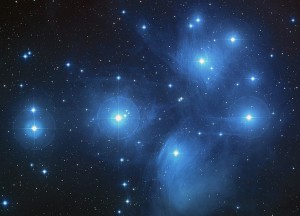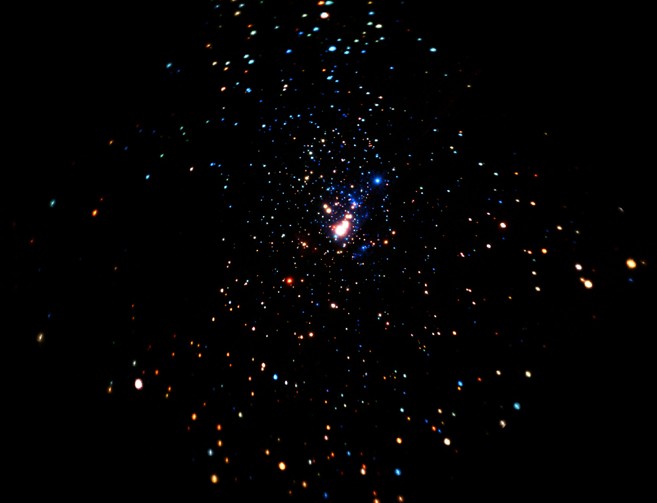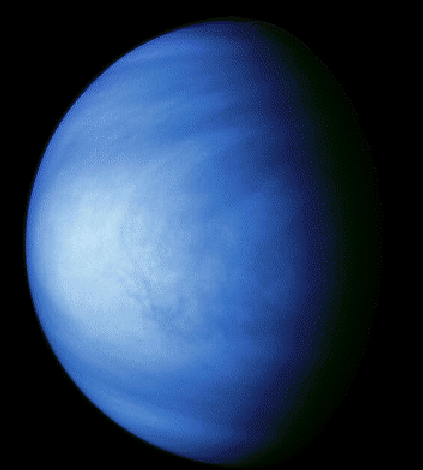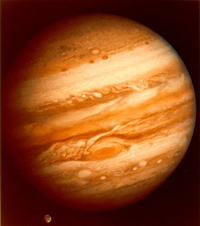Posts Tagged ‘jupiter’
1st Star Gaze Of The Year
After several months of pants weather in the evenings which stopped me from doing any stargazing, last night finally had a clear enough sky to have a good look again. The moon was ideally positioned as well which made the stars and planets on show very bright. I didn’t get the telescope out this time but used my binoculars instead to have a scan around the Sky.
The most noticeable object in the Sky was the planet Jupiter which was shining very brightly, so I had a good look at it and managed to pick out three of Jupiter’s moons. One was to the right of it and two more underneath it, and I could also just pick out the horizontal storms raging across the planet. As I was using binoculars, the image wasn’t very steady, so I was desperately trying to lean against the shed to steady myself!
Once I had had a good look at Jupiter, I had a look at the Pleiades (also known as ‘The Seven Sisters’) which are one of my favourite things to view in the night sky. They were shining brilliantly via the binoculars although quite dimmed out when looking with the naked eye. It still amazes me how well you can see these stars through a telescope or binoculars as it really brings them to life! The Pleiades are located in the constellation of Taurus and are one of the closest star clusters to Earth. Here is a great photo of them from the NASA website.
The final section of the sky that I had a good look at last night was the Orion Nebula which is situated in the sword of the constellation Orion. As the Nebula is in the middle of the three star sword, it is easily spotted in the sky. You can just make out a blurry area with the naked eye, but using the binoculars as I was, I had a great view of the Nebula. The Nebula is also known as M42 and is 24 light years across with the mass being almost 2000 times that of the Sun. It is also the closest star forming region to the Earth which adds to its significance. I find it amazing to look at this and imagine new stars and worlds being formed in a distant part of the galaxy. Here is a photo of the Orion Nebula from the NASA website.
Here’s hoping for more clear skies over the next few weeks!
Comet Spotting – Attempt #3
Last night we went out again to try and find Comet Pan-Starrs as it was a clear night, but unfortunately, we didn’t manage to see it. There was a band of cloud along the horizon where I am sure the Comet would have been, and it was also very frosty so the atmosphere of the Earth wasn’t as clear as it had been the previous nights when we have been out. It was a bit of a shame, but we at least saw the Comet on our second attempt which was great!
Instead last night, we had a look around at the other objects in the Sky with our binoculars. Jupiter was very bright and you could see a couple of it’s Moon’s shining beside it, and we also had a good look at the Pleiades (also known as the ‘Seven Sisters’ as they are a group of seven stars that shine very brightly. The Pleiades were clear as a bell through the binoculars and were a great site! Finally, we had a go at looking for the Orion Nebula and that was showing really well. You could see a blurry, but large, mass of stars which make up the Nebula in the sword of the Constellation Orion (just south of Orion’s belt). It was a great view!
So whilst we were annoyed we couldn’t see the Comet again, we had a good time looking at some of the other features that make up the night sky!
Stargazing
If you can get out this week, it is a great opportunity to do some Stargazing as the skies around the country are very clear at night time at the moment!
The Moon is quite small at the moment so the light from it isn’t quite bright enough to hide all the Stars. The brighter ones can still be seen very well especially Sirius (the Dog Star), Betelgeuse (the red coloured top left star in the constellation Orion) and Aldebaran (which is another red coloured star in the constellation Taurus). But the best object by far in the sky at the moment is the planet Jupiter. It is currently situated near to the Moon each night which makes it easy to spot. Jupiter’s Moons are also very clear at the moment and if you use a telescope, you can see at least four of them shining brightly around the huge planet (depending on where they are in their orbits). You can also just make them out using a decent pair of binoculars.
I had a great half an hour on Sunday night (before I nearly froze to death!) looking at the Moon and Jupiter. I could see the craters on the Moon very clearly as it was shining bright. I also had a great look at Jupiter and saw three Moons to start with, but then whilst I was watching, a fourth Moon peeped out from behind the giant planet. All four were shining brighter than I had probably seen them shine before. I could also see two of the purple coloured storm bands moving around the planet, just above and below the centre of Jupiter. It was an amazing sight and whenever I view Jupiter, I can never really believe what I am seeing! It’s that fantastic and awe-inspiring to me.
So take advantage of the clear skies and fine weather and do a bit of Stargazing tonight and let me know what you see by either leaving a comment on this post or tweeting me at @strethewey. Enjoy the viewing!
Venus
Out of the planets that I had seen through my telescope, I hadn’t seen Venus properly until the end of January this year. Venus has been, and still is, very bright in the sky and at the end of January it was perfectly placed to view in my back garden.
Before viewing the planet, I wasn’t sure what I was going to see. I knew the planet was a sphere and had a blue tint to it but didn’t think that I would see it like that, and I knew it didn’t have any rings so I think I was just expecting to see something like a star in the sky.
It took a couple of nights to actually view Venus properly as on the first night I tried, it was slightly misty, so the planet wasn’t well spotted. The next night, I waited until it got too dark, so too much light was reflecting from it which dazzled through the telescope. I then read up on viewing Venus and found the best time to view it was at dusk when it was still slightly light and the planet wasn’t too bright. So on my third attempt, I had the telescope outside ready for dusk and saw Venus brilliantly through it!
To my surprise, it did actually look blue! It was like viewing a bluish ball just hanging in Space. It obviously didn’t have the grandeur of Jupiter (Moons and storm clouds) or Saturn (rings) but it was great to see a planet that looked different to the others that I had seen. I was very pleased with what I saw, to say the least! The image below is the closest one I could find that looked like what I saw (obviously what I saw was the whole planet and not the half that was in the light). My telescope is not powerful enough to view the planet in the size below, but I could still see it very well!
Venus is still going to be very bright in the sky over the next couple of months, so if you can, I would try and get out and view it! In fact, the planet is meant to be as bright as the Moon and will cast shadows, which I find very interesting indeed. The best time to test this would be towards the middle of the month (March) when there is no Moon in the Sky, so Venus should be the main light source during clear nights.
Happy Venus spotting!
Jupiter
It has now been a whole year since I received my telescope for my 30th birthday, and I have learnt so much in that time!
It was exactly a year ago that I found out which bright light in the sky was Jupiter so I thought that I would go out and view it again, now that I have had more experience with the telescope.
I wasn’t disappointed either as I managed to home in on the Red Planet pretty quickly and got it into focus using several lenses with minimal trouble. What I saw was again brilliant and I could make out four of Jupiter’s moons beside it. In fact, whilst I was looking at the planet, one of the moon’s popped out from behind the right hand side of it, which I thought was great! 😉 I could also make out the swirling colours of Jupiter when I used the highest magnification lens that was available to me.
Overall, I was very pleased with the evening’s Astronomy and it showed that I have definitely learnt loads about the night sky in the past year.
N.B. Jupiter is currently very bright in the Sky and is one of the first objects that you can see during and after dusk. You can’t miss it! 😉
The photograph of Jupiter below was taken by the Voyager 1 Spacecraft when it was still more than 25 million miles away on January 24th 1979. The object on the bottom left is Ganymede which is Jupiter’s largest Moon.



